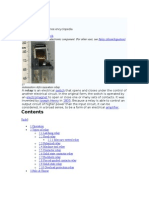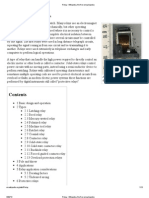0 ratings0% found this document useful (0 votes)
80 viewsKnife Switch - Wikipedia
Knife Switch - Wikipedia
Uploaded by
Sheraz KhanA knife switch is a simple type of switch that controls electricity flow by inserting or lifting a metal lever into a slot. It has exposed metal parts that present a risk of electric shock. Modern switches like circuit breakers are enclosed and use rapid opening mechanisms to reduce arcing, preventing injury from accidental contact. Knife switches were replaced by safer enclosed switches that only open when power is off.
Copyright:
© All Rights Reserved
Available Formats
Download as PDF, TXT or read online from Scribd
Knife Switch - Wikipedia
Knife Switch - Wikipedia
Uploaded by
Sheraz Khan0 ratings0% found this document useful (0 votes)
80 views7 pagesA knife switch is a simple type of switch that controls electricity flow by inserting or lifting a metal lever into a slot. It has exposed metal parts that present a risk of electric shock. Modern switches like circuit breakers are enclosed and use rapid opening mechanisms to reduce arcing, preventing injury from accidental contact. Knife switches were replaced by safer enclosed switches that only open when power is off.
Original Description:
T
Copyright
© © All Rights Reserved
Available Formats
PDF, TXT or read online from Scribd
Share this document
Did you find this document useful?
Is this content inappropriate?
A knife switch is a simple type of switch that controls electricity flow by inserting or lifting a metal lever into a slot. It has exposed metal parts that present a risk of electric shock. Modern switches like circuit breakers are enclosed and use rapid opening mechanisms to reduce arcing, preventing injury from accidental contact. Knife switches were replaced by safer enclosed switches that only open when power is off.
Copyright:
© All Rights Reserved
Available Formats
Download as PDF, TXT or read online from Scribd
Download as pdf or txt
0 ratings0% found this document useful (0 votes)
80 views7 pagesKnife Switch - Wikipedia
Knife Switch - Wikipedia
Uploaded by
Sheraz KhanA knife switch is a simple type of switch that controls electricity flow by inserting or lifting a metal lever into a slot. It has exposed metal parts that present a risk of electric shock. Modern switches like circuit breakers are enclosed and use rapid opening mechanisms to reduce arcing, preventing injury from accidental contact. Knife switches were replaced by safer enclosed switches that only open when power is off.
Copyright:
© All Rights Reserved
Available Formats
Download as PDF, TXT or read online from Scribd
Download as pdf or txt
You are on page 1of 7
Knife switch
1917 motor switch, with extra contacts
Open knife switch
Dual pole, dual throw knife switch in one of its two
closed positions.
A knife switch is a type of switch used to
control the flow of electricity in a circuit. It
is composed of a hinge which allows a
metal lever, or knife, to be lifted from or
inserted into a slot or jaw. The hinge and
jaw are both fixed to an insulated base,
and the knife has an insulated handle to
grip at one end. Current flows through the
switch when the knife is pushed into the
jaw. Knife switches can take several forms,
including single throw, in which the "knife"
engages with only a single slot, and double
throw, in which the knife hinge is placed
between two slots and can engage with
either one. Also, multiple knives may be
attached to a single handle and can be
used to activate more than one circuit
simultaneously.
Current uses
Though used commonly in the past, knife
switches are now rare, finding use largely
in science experiments where the position
of the switch may be plainly seen in
demonstration. The knife switch is
extremely simple in construction and use,
but its exposed metal parts present a great
risk of electric shock, and the switch is
subject to arcing when opened at higher
voltages, which poses a further risk of
shock or burns to the operator and can
cause fires or explosions under certain
conditions.
Open knife switches were supplanted by
safety switches with current carrying
contacts inside a metal enclosure which
can only be opened by switching off the
power. In modern applications, automatic
switches (such as contactors or relays),
and manual switches such as circuit
breakers are used. These devices use a
snap action mechanism which opens the
switch contacts rapidly, and feature an arc
chute where the arc caused by opening
the switch is quenched. These devices
also prevent injury due to accidental
contact, as all of the current carrying metal
parts of the switch are hidden within or
surrounded by insulating guards.
References
Wikimedia Commons has media related to
Knife switches.
"Basic Electricity" . Retrieved
2007-06-01.
"Resistance" . Retrieved 2007-06-01.
unknown writer (1981), The Electrical
Distributor, General Electric literature
This engineering-related article is a stub.
You can help Wikipedia by expanding it.
Retrieved from
"https://en.wikipedia.org/w/index.php?
title=Knife_switch&oldid=830578008"
Last edited 8 months ago by Störm
Content is available under CC BY-SA 3.0 unless
otherwise noted.
You might also like
- Specification Cetiol SensoftDocument2 pagesSpecification Cetiol Sensoftmengyizhu668No ratings yet
- Software Test PlanDocument7 pagesSoftware Test PlanSabahat Hussain100% (2)
- ARC Additional Problems MWFDocument5 pagesARC Additional Problems MWFonly. starNo ratings yet
- ContactorsDocument3 pagesContactorsGalco IndustrialNo ratings yet
- Resistance: ConductorsDocument6 pagesResistance: ConductorsKokoArdNo ratings yet
- Switch Types: Chapter 4 - SwitchesDocument6 pagesSwitch Types: Chapter 4 - SwitchesNafie PieeNo ratings yet
- 1 5 ResistanceDocument7 pages1 5 ResistancetestyNo ratings yet
- Manufacturer List On Electromechanical Switches ElectronicomhhvyelujDocument1 pageManufacturer List On Electromechanical Switches Electronicomhhvyelujfamilygemini22No ratings yet
- Parts of A Magnetic ContactorDocument15 pagesParts of A Magnetic ContactorPriince Dwi Ght100% (2)
- The Best Electrical Controls Business On The Planet!: Page 1 of 8Document8 pagesThe Best Electrical Controls Business On The Planet!: Page 1 of 8nandiniNo ratings yet
- Switch, and They Are Manufactured in Several VarietiesDocument6 pagesSwitch, and They Are Manufactured in Several VarietiesRoop GoswamiNo ratings yet
- Motor Control and ProtectionDocument23 pagesMotor Control and ProtectionIsaac KimaruNo ratings yet
- Introduction To Switch Gear and ProtectionDocument12 pagesIntroduction To Switch Gear and ProtectionKrishna PrasadNo ratings yet
- Circuit Breakers, Fuses and SwitchesDocument2 pagesCircuit Breakers, Fuses and SwitchesbilalNo ratings yet
- Contactor ElectricDocument5 pagesContactor ElectricIgor PadureNo ratings yet
- Circuit Breaker?Document17 pagesCircuit Breaker?Prince DhartNo ratings yet
- Unit 04Document39 pagesUnit 04ptarwatkar123No ratings yet
- Lecture 12 High Voltage SwitchesDocument9 pagesLecture 12 High Voltage SwitchesMehmet Efe OzbekNo ratings yet
- ActuatorsDocument22 pagesActuatorsmanjunathNo ratings yet
- ElectromagnetDocument1 pageElectromagnetIdasary IbrahimNo ratings yet
- "Safety Switch" "Meaning"Document4 pages"Safety Switch" "Meaning"jcfish07No ratings yet
- Basics of Motor Starters and ContactorsDocument37 pagesBasics of Motor Starters and ContactorsTrifonas Krommidas100% (1)
- What Is An Electrical Switch?Document6 pagesWhat Is An Electrical Switch?Aeylla ZeoraineNo ratings yet
- Relay: Reported By: Lorenzo Omiping Bit 1D (Night)Document17 pagesRelay: Reported By: Lorenzo Omiping Bit 1D (Night)Jasper ParkNo ratings yet
- Germany Manufacturer Producer Switch EuropageswfnzojujimDocument1 pageGermany Manufacturer Producer Switch Europageswfnzojujimjumperfeet45No ratings yet
- Electrically Switch Electromagnet Solid-State RelaysDocument4 pagesElectrically Switch Electromagnet Solid-State RelaysOMSURYACHANDRANNo ratings yet
- Wiring Devices and Other Electrical MaterialsDocument33 pagesWiring Devices and Other Electrical MaterialsJoyce LapuzNo ratings yet
- Protective Relay - Wikipedia, The Free EncyclopediaDocument6 pagesProtective Relay - Wikipedia, The Free EncyclopediakishoreneveNo ratings yet
- Principle of Operation of Circuit BreakersDocument13 pagesPrinciple of Operation of Circuit BreakersSanjay MathurNo ratings yet
- Isolators and ContactorsDocument7 pagesIsolators and ContactorsAvishek SapkotaNo ratings yet
- What Is ContactorDocument7 pagesWhat Is ContactorDilip Gangopadhyay100% (1)
- Lectura 1 InglésDocument2 pagesLectura 1 InglésMiguel CaballeroNo ratings yet
- Coil of Wire Surrounding A Soft Iron CoreDocument15 pagesCoil of Wire Surrounding A Soft Iron Coreprem035No ratings yet
- ContactorDocument22 pagesContactorirfanrifkyNo ratings yet
- Contactor - WikipediaDocument8 pagesContactor - Wikipediaomarbinsalum76No ratings yet
- Description: Electromechanical Electrical ContactsDocument2 pagesDescription: Electromechanical Electrical ContactsracNo ratings yet
- Wa0009.Document11 pagesWa0009.tribhuvansamadhan01No ratings yet
- Miniature Snap-Action SwitchDocument3 pagesMiniature Snap-Action SwitchRobin TimkangNo ratings yet
- What Is A Circuit BreakerDocument18 pagesWhat Is A Circuit Breakersrinu247100% (1)
- Circuit Breaker: For Other Uses, SeeDocument13 pagesCircuit Breaker: For Other Uses, SeekallugNo ratings yet
- EXP 1-9 FinalDocument28 pagesEXP 1-9 FinalMonika KanojiaNo ratings yet
- Assignment 3Document13 pagesAssignment 3Ifeoluwa VictoriaNo ratings yet
- Relay DetailsDocument15 pagesRelay DetailsstarNo ratings yet
- Relay: This Article Is About The Electronic Component. For Other Uses, SeeDocument11 pagesRelay: This Article Is About The Electronic Component. For Other Uses, SeeAkash MohantyNo ratings yet
- Relay - Wikipedia, The Free EncyclopediaDocument13 pagesRelay - Wikipedia, The Free EncyclopediakghlkhglkghklNo ratings yet
- relay 2Document13 pagesrelay 2marranNo ratings yet
- Annex B Relay Construction: Protection Systems & Devices (Relays) 3 YearDocument3 pagesAnnex B Relay Construction: Protection Systems & Devices (Relays) 3 Yearnassim.1979No ratings yet
- Systematic Analysis of Induction Coil FailuresDocument2 pagesSystematic Analysis of Induction Coil FailuresGaddipati MohankrishnaNo ratings yet
- RelayDocument10 pagesRelayhighview1738No ratings yet
- Operating Principle of A Contactor:: Holds The Moving and Fixed Contacts Together. in The ProcessDocument15 pagesOperating Principle of A Contactor:: Holds The Moving and Fixed Contacts Together. in The ProcessAnand JainNo ratings yet
- Electronic Switch: Rajasthan Technical University, KotaDocument21 pagesElectronic Switch: Rajasthan Technical University, KotaGajendra NagarNo ratings yet
- Switchgear Lab ManualDocument40 pagesSwitchgear Lab ManualZeeshan Ahmed100% (2)
- 6th Ele SGPDDocument118 pages6th Ele SGPDAkash RawatNo ratings yet
- Contactor: Construction Operating Principle Arc Suppression RatingsDocument6 pagesContactor: Construction Operating Principle Arc Suppression Ratingsalex cassonNo ratings yet
- RelayDocument11 pagesRelayKishan PatelNo ratings yet
- Electrical Circuit Breaker - Operation and Types of Circuit Breaker - Electrical EngineeringDocument4 pagesElectrical Circuit Breaker - Operation and Types of Circuit Breaker - Electrical EngineeringBattinapati ShivaNo ratings yet
- Electrically Switch Electromagnet Solid-State Relays: RelayDocument8 pagesElectrically Switch Electromagnet Solid-State Relays: RelayAmiel Ohween AnayNo ratings yet
- Buy Products Send-In Repair On-Site Repair Engineered Systems Galco TV My AccountDocument8 pagesBuy Products Send-In Repair On-Site Repair Engineered Systems Galco TV My AccountTanveer Ul HaqNo ratings yet
- Electrical Circuit Breaker - Operation and Types of Circuit BreakerDocument46 pagesElectrical Circuit Breaker - Operation and Types of Circuit Breakerkumelachewbirre22No ratings yet
- Relays and Mechanical SwitchesDocument1 pageRelays and Mechanical SwitchesKiran Jot SinghNo ratings yet
- Circuit Breakers & IsolaterDocument3 pagesCircuit Breakers & IsolaterManish GautamNo ratings yet
- Relay: Relay Is Basically A Magnetism Based Switch. It Consists of A Coil Through Which Current Passes and OnDocument9 pagesRelay: Relay Is Basically A Magnetism Based Switch. It Consists of A Coil Through Which Current Passes and OnAnonymous v5QjDW2eHxNo ratings yet
- What's The Difference Between A Megger & Hi-Pot Test - HunkerDocument5 pagesWhat's The Difference Between A Megger & Hi-Pot Test - HunkerSheraz KhanNo ratings yet
- Guidelines For High Potential (Hi-Pot) DC Testing of Medium Voltage Cables - EEPDocument11 pagesGuidelines For High Potential (Hi-Pot) DC Testing of Medium Voltage Cables - EEPSheraz Khan100% (2)
- Calculate IDMT Over Current Relay Setting (50 - 51) - Electrical Notes & ArticlesDocument3 pagesCalculate IDMT Over Current Relay Setting (50 - 51) - Electrical Notes & ArticlesSheraz KhanNo ratings yet
- YBLX-JW2 Travel SwitchDocument3 pagesYBLX-JW2 Travel SwitchSheraz KhanNo ratings yet
- Account Number: 02530010035451090019 Account Title: GHULAM YASIN Currency: PKR Opening Balance: 159,365.40 Closing Balance: 175,439.80Document1 pageAccount Number: 02530010035451090019 Account Title: GHULAM YASIN Currency: PKR Opening Balance: 159,365.40 Closing Balance: 175,439.80Sheraz KhanNo ratings yet
- PG&E 500 KV Protection Standard Design and DevelopmentDocument15 pagesPG&E 500 KV Protection Standard Design and DevelopmentSheraz KhanNo ratings yet
- Automated Attendance System: Page - 1Document67 pagesAutomated Attendance System: Page - 1Sheraz KhanNo ratings yet
- Title: Unique Identifier: Document Type: Revision: Effective Date: Total Pages: Review DateDocument13 pagesTitle: Unique Identifier: Document Type: Revision: Effective Date: Total Pages: Review DateSheraz KhanNo ratings yet
- Structure of Discussion EssayDocument3 pagesStructure of Discussion EssaySheraz KhanNo ratings yet
- Excavating ADocument2 pagesExcavating AZakirhasNo ratings yet
- SAS 1 ELE 106 Distribution System and Substation DesignDocument7 pagesSAS 1 ELE 106 Distribution System and Substation DesignArnold GacangNo ratings yet
- BPR Case StudyDocument5 pagesBPR Case StudyAmol PhadaleNo ratings yet
- Voltas 6,8 and 10kw Standard Settings.Document5 pagesVoltas 6,8 and 10kw Standard Settings.zaid.naeemNo ratings yet
- HSPICE Tutorial PDFDocument7 pagesHSPICE Tutorial PDFXman-exNo ratings yet
- Bioaccumulation of PB, CD, Cu, and CR by Porphyridium Cruentum (S.F. Gray)Document7 pagesBioaccumulation of PB, CD, Cu, and CR by Porphyridium Cruentum (S.F. Gray)nurul_595600924No ratings yet
- LeachingDocument11 pagesLeachingFakhirah Ahmad BasriNo ratings yet
- Apartment - Geotechnical Investigation Report - 31-07-2019Document30 pagesApartment - Geotechnical Investigation Report - 31-07-2019sam09132100% (1)
- Rotodynamic Machines: Engine or Motor Is UsedDocument25 pagesRotodynamic Machines: Engine or Motor Is UsedWika ElmasryNo ratings yet
- STI WS100SG2 Instruction ManualDocument24 pagesSTI WS100SG2 Instruction ManualJMAC Supply100% (1)
- Olympic Kayak Makes WavesDocument1 pageOlympic Kayak Makes WavesBovyNo ratings yet
- DCMANUALDocument306 pagesDCMANUALdemothisesNo ratings yet
- ZFS CommandsDocument3 pagesZFS CommandsMohammad ImtiyazNo ratings yet
- Hotbodies Undertail Ninja 250/300Document5 pagesHotbodies Undertail Ninja 250/300Oiem AdjahNo ratings yet
- Unit-2 (Part-C) Notes of OOP (KOE-064) Subject (Sequence and State Diagrams) by Updesh JaiswalDocument7 pagesUnit-2 (Part-C) Notes of OOP (KOE-064) Subject (Sequence and State Diagrams) by Updesh Jaiswalviku9267No ratings yet
- 6-Chapter7 - External Forced ConvectionDocument24 pages6-Chapter7 - External Forced ConvectionAzarul AzuwadNo ratings yet
- Virtual Base ClassDocument17 pagesVirtual Base ClassSrijana Shet YiascmNo ratings yet
- Microwave Frequency BandsDocument2 pagesMicrowave Frequency BandsbalajiNo ratings yet
- Deutz: ® ETL No.: 0507 7031 Cylinder Head Constr. Group: 08 SERPIC © 10.17Document2 pagesDeutz: ® ETL No.: 0507 7031 Cylinder Head Constr. Group: 08 SERPIC © 10.17Simon AlbertNo ratings yet
- Grundfos AQpureDocument5 pagesGrundfos AQpureEddie GuillénNo ratings yet
- Ficha Tecnica Reflector 300WDocument8 pagesFicha Tecnica Reflector 300WRene Alejandro BarillasNo ratings yet
- Electricity Procedure UnitacDocument16 pagesElectricity Procedure UnitacaneeshkadapuzhaNo ratings yet
- Witt PDFDocument10 pagesWitt PDFAfner OtnielNo ratings yet
- MEC3458 Final ReportDocument16 pagesMEC3458 Final ReportangelaersNo ratings yet
- Thomson VTH 7090 VCR ManualDocument33 pagesThomson VTH 7090 VCR ManualTrickyDicky2No ratings yet
- 185 SQMM For 300kw Wattpower InverterDocument1 page185 SQMM For 300kw Wattpower Inverterharikrushan.patelNo ratings yet
- Application of BIM in Design Conflict Detection: A Case Study of VietnamDocument11 pagesApplication of BIM in Design Conflict Detection: A Case Study of VietnamshashiNo ratings yet


































































































